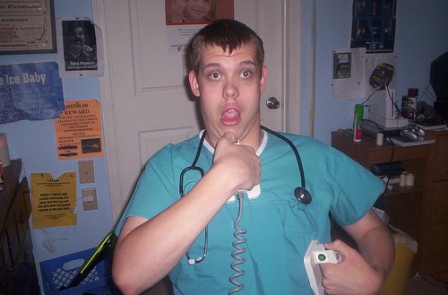
Ah, it used to be such a simple affair.
A simple dance between doctor and nurse and patient. A little oxygen applied, an IV started, a drug administered. The melodic cadence of the monitor chirping softly as the patient drifted off to sleep, eyes heavy, jaw dropping open. Yes, a little sleepy time in the office and then....
BLAM! A few gazillion volts were applied across the chest to restore the heart rhythm to normal. The patient would reflexly jerk, sometimes catching the doctor between the legs with their flailing hand. A nurse would chuckle as she supported the airway while the doctor tossed his cookies, then grabbed the closest chair to regain his composure, all the while sputtering to thank the nurse for her assistance with the patient, but next time, could she please place a sheet over the patients hands and arms to prevent this kind of thing?
In those days, costs were low, treatment effective. Nurses and doctors had time to monitor the patient. By and large, patients did well.
The glory days of medicine.
Today, the procedure is the same, but very different. No longer is cardioversion performed in the office, but the hospital. Why? They tell me it's safer. It certainly is easier for me. No more hassle and worry. Just schedule it, have the patient all prepped and ready to go. We have anesthesiologists and nurse anethesthetists who manage the airway for me, sophisticated monitors that record oxygen saturation, blood pressure, respirations, and a whole host of other parameters that we never use. We say "time-out" and make sure we have the the right patient and we're shocking the one heart in the center of the chest and not another heart somewhere else. We have biphasic defibrillators that are effective with only 100 joules instead of 360, but we have the 360-joule model just in case a patient is the size of Toledo. We give innovative (and expensive) ultra-short anesthetics that metabolize so fast that respiratory complications are rare, but the credentials committee has deemed can only be adminstered by an anesthesiologist or his or her nurse helper. We use bite blocks or rolls of gauze to prevent a patient from accidentially biting their tongue. And we get an EKG after the procedure to show the lawyers we really did what we said we did, see? And the whole thing is documented on an electronic medical record that records the drugs, and the vital signs, the pre-sedation note, the procedure note, the diagnoses, and ties them to the right ICD-9 codes, and shoots the bill to the coders, billing consultants, business managers and insurers, all at the speed of light so the bill is posted before the patient even awakens. All as the doctors and nurses work as a team to assure a pleasant experience for the patient and their family.
Yes, the glory days once more, but different.
And the patient goes home, just as before, with the chance for legal liability reduced. It is safer and more efficient for everyone, really it is. (Although I've not seen the data on this, except here).
And soon, we'll reach even better heights, with more coding, efficiency, safety initiatives, and oversight. More efficiency. More safety. And fewer medical errors. All while holding down the costs in our new, improved health care system of tomorrow.
Yep, we'll reach the land of milk and honey and the glory days will be even better.
Really they will.
Except when they still forget to strap down the patient's arms.
-Wes
Picture reference: widerider107.
1 comment:
If you look at the bottom of the inscrutable bill that never gets paid, you will see this line:
$13 (because everything has to be marked up, doubly so if it is reused), one-time use of cup by doctor
Post a Comment